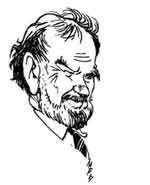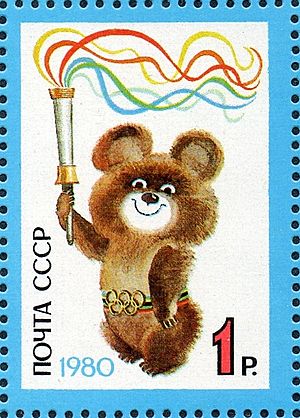Yevgeniy Migunov facts for kids
Quick facts for kids
Yevgeny Migunov
|
|
|---|---|

Yevgeny Migunov, self-portrait
|
|
| Born |
Yevgeny Tikhonovich Migunov
27 February 1921 |
| Died | 1 January 2004 (aged 82) Moscow, Russia
|
| Occupation | Animator, artist |
Yevgeny Tikhonovich Migunov (Russian: Евгений Тихонович Мигунов; February 27, 1921 – January 1, 2004) was a talented Russian artist. He was known for many things, including being a cartoonist, book illustrator, and animation director. He also wrote screenplays, invented new techniques, and taught others. Migunov is seen as a major innovator during a time called the Khrushchev Thaw. He made big contributions to both traditional and stop motion animation.
Contents
Early Life and Education
Yevgeny Migunov was born in Moscow with his sister Nina. His father, Tikhon Grigorievich Migunov, worked for the government. His mother, Maria Konstantinovna Migunova, passed away in 1928. Yevgeny had a condition called cerebral palsy that affected his left leg. He learned to hide it and lived a very active life.
In 1928, Migunov finished school and then studied art for a year. In 1939, he joined the new Art Faculty at VGIK. This was a famous film school. He was one of the first students in the animation workshop. His teachers included famous artists like Ivan Ivanov-Vano. Migunov worked hard to learn art by studying classic Russian paintings. He also learned a lot from his friend and future partner, Anatoly Sazonov. To earn money, Migunov drew small pictures for the Novodevichy Convent Museum.
War Years and Film School
When World War II started in 1941, Migunov joined the army as a volunteer. He hid his disability to serve his country. He later received an award for his service. In the autumn of 1941, he returned to VGIK. But when the Battle of Moscow began, the school moved to Alma-Ata. There, he and his classmates continued their studies. They held art shows and worked on cartoon ideas. In 1943, Migunov completed his final project. It was a Let's Laugh storyboard based on his own story. A famous director, Sergei Eisenstein, was part of the judging committee.
Animation Career
Starting in Animation
In September 1943, VGIK moved back to Moscow. That same year, Migunov and his classmates joined Soyuzmultfilm. This was a major animation studio. They finished their first cartoon, Stolen Sun, which is now lost. In 1945, Migunov and Sazonov worked as art directors on The Lost Letter. This was the first full-length Soviet animated movie. In 1946, they helped restore The Song of Happiness. This short film won an international award for its animation and message.
Migunov also created teaching programs for animation courses at Soyuzmultfilm. He taught how to design characters. In 1948, he worked on the short comedy Champion. This was the first cartoon to use oil paints for backgrounds. Around this time, there was a campaign against the style of Disney cartoons. Champion was criticized for being too "formal" and making animals too human-like. To show his point, Migunov made his next film, Polkan and Shavka, as realistic as possible. Surprisingly, it became a model for other animators for many years.
In 1951, the short film When New Year Trees Light Up won an award. It was chosen as the best children's movie at a film festival. In the years that followed, Migunov became one of the most important innovators at Soyuzmultfilm.
New Ideas in Animation
In 1953, the puppet animation department at Soyuzmultfilm reopened. The next year, Migunov directed his first film, Karandash and Klyaksa — Merry Hunters. This was the first stop motion animated film made after the war. It was inspired by a popular Russian clown named Karandash. Migunov completely changed how these films were made. He designed new equipment for shooting scenes and using puppets with movable joints. He also suggested using latex for puppet faces. He and a mechanic, Semyon Etlis, built and patented these new devices. Migunov even wrote the story and sang in the film. The movie was very successful. However, the clown Karandash complained, and Migunov left puppet animation.
In 1957, Migunov directed a traditional animated short called Familiar Pictures. It was based on comedy sketches by Arkady Raikin. This film was a big change from the "realistic" animation style. It used a style more like magazine cartoons. This was because Raikin's comedy was satirical and didn't fit the old art style. Soon, other animators started to create their own unique styles too.
Migunov also worked on some projects that were never released. One was Dyatel (Woodpecker), a satirical animated series. He used new techniques like cutout animation and split screens. This project later inspired other famous animated shows. Another film, World! World! World!!!, was approved in 1959 but never aired. Film historians say it was a very new way of making animated films.
By 1960, Migunov had disagreements with the studio management. His last project was based on two poems. He presented it in a way that went against the rules. This led to a big argument, and Migunov was fired from Soyuzmultfilm.
Illustrator and Artist
After leaving animation, Yevgeny Migunov focused on art and illustrations. He created filmstrips for a studio called Diafilm. He also drew cartoons and caricatures for many magazines, like Krokodil (a satirical magazine) and children's magazines like Murzilka and Merry Pictures. His drawings also appeared in newspapers.
He spent many years working for the Detskaya Literatura publishing house. He illustrated children's books and fantasy novels. He used his animation experience to make his drawings look like they were moving. Some of his most famous illustrations were for books by the Strugatsky Brothers, Aleksandr Volkov's Emerald City novels, and Yevgeny Veltistov's Electronic: A Boy From a Suitcase. He is most famous for his work on Kir Bulychov's Alisa Selezneva series. They worked together for almost 40 years. Migunov even gave Bulychov ideas for his stories. In 1980, another director asked Migunov to work on The Mystery of the Third Planet, which was based on Alisa Selezneva's adventures. But Migunov said no. He later felt that some characters in the cartoon looked too much like his own illustrations.
Yevgeny Migunov also helped design Misha, the Russian Bear mascot for the 1980 Summer Olympics in Moscow. After another artist, Victor Chizhikov, made the main sketch, Migunov created 21 sets of images for other artists and advertisers. These images showed Misha doing different things, like greeting guests or holding the Olympic torch.
Later Years and Legacy
From 1997, Migunov worked on a collection of Kir Bulychov's stories. He made hundreds of illustrations, but only two thin books were published. Many of his drawings were never seen by the public. In 1999, he had a stroke and could no longer draw. However, he could still guide others in coloring his work. He also left many notebooks filled with his memories. These included stories about his youth, people he met, and his thoughts on art and animation. He considered these notes his "major life accomplishment." Only parts of them have been published so far.
Yevgeny Migunov passed away on January 1, 2004. He was buried in Moscow. He was survived by his wife, Nina Romanovna Karavaeva, who was also an animator.
Filmography
- Actress (1942) - opening sequence (uncredited)
- Stolen Sun (1943) – art director
- The Lost Letter (1945) – art director
- Winter Tale (1945) – art director
- The Song of Happiness (1946) – art director
- Merry Garden (1947) – art director
- Quartet (1947) - art director
- Champion (1948) - art director
- An Elephant and an Ant (1948) – art director
- Polkan and Shavka (1949) – art director
- Mister Wolk (1949) – consultant (uncredited)
- When New Year Trees Light Up (1950)
- A Grandpa and a Grandsonny (1950) - art director
- Who's First? (1950) - art director
- Forest Adventurers (1951) - art director
- Magic Shop (1953) - art director
- Karandash and Klyaksa — Merry Hunters (1954) – director, art director, screenwriter, voice
- A Pipe and a Bear (1955) - art director
- What Kind of Bird Is This? (1955) - director, art director, songwriter
- Familiar Pictures (1957) - director, art director
- To the 6th World Festival (1957) – director, art director, screenwriter
- A Song About Friendship (1957) – art director
- Poem of the Sea (1958) – director, art director (animated sequences)
- Exactly at Three Fifteen... (1959) – director, art director, screenwriter
- Oversalted (1959) – screenwriter
- World! World! World!!! (1959) – screenwriter (unfinished)
- S. Marshak (1960) – director (animated sequences)


